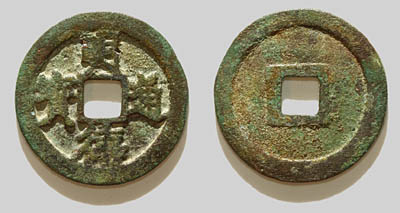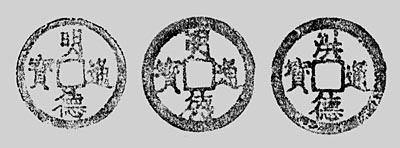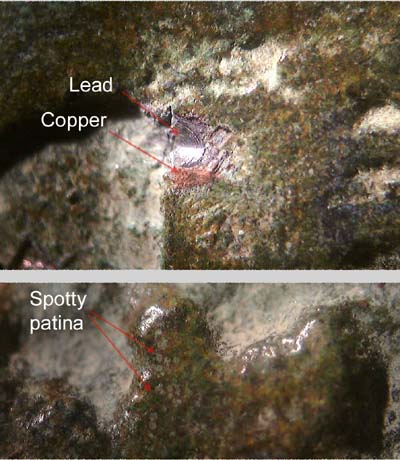
Forgery, Manipulation and addition of multiple metals. Minh Đức Thông Bảo, 明德通寶. The excellent Minh Đức forgery on the right was made by replacing the top character Hồng of a Hồng Đức Thông Bảo with the character Minh. The work is so good that it's virtually impossible to find evidence of the manipulation. The only things that draw suspicion to the coin are its calligraphy and rims. Although the coin is similar to the real Minh Đức coin, its calligraphy is slightly different and the rims are wider. Minh Đức coins have only a few specific styles with no variation, thus this piece is suspect. It's a common practice to produce forgeries by replacing characters when less expensive coins with similar style exist. The top character is the only dif-ference between Hồng Đức and Minh Đức so Hồng Đức is an obvious choice for the work. The weakness of this approach is that the calligraphy does not exactly match that of any known Minh Đức variety. The second figure shows the forgery along with rubbings of Minh Đức on the left and Hồng Đức on the right. A careful comparison of the rubbings shows that the style and calligraphy are from the Hồng Đức coin, particularly the character Bảo. Although there are no obvious signs of manipulation, the coin is confirmed to be a forgery by testing the structure of the top character with a cutting tool, and by microscopic examina-tion of the patina. The same patina that covers the top character covers the entire coin, thus if the top character is artificial then all the patina on the coin must also be artificial. The top microscopic view shows the left side of the top character Hồng where a piece of material was cut away revealing that the character was crafted from lead. A thick layer of copper covers the top of the lead and the whole structure is coated with artificial patina. The copper layer was probably added to help the patina adhere to the lead character. This method of building a fake character is unusually sophisticated and the use of plastic materials is more common. The bottom microscopic view shows the top part of the Thông where the patina looks most artificial. Note that the layer of patina is smooth and uniform but the colors of the patina have a spotty appearance. This spotty effect is not natural and is sometimes produced by mixing various colored materials with glue or other bonding agents. The colored material is often produced by grinding up patina scraped off real coins. |
  9
 |
||